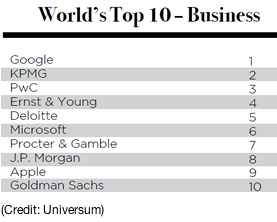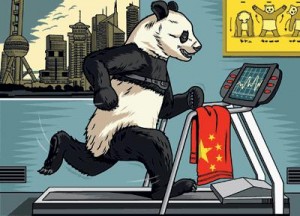The Power of Empowerment: An Effective Approach to Conflict Resolution
In response to Melissa Lui’s conclusive blog “Work With Me!!”, it was interesting to find that disempowering an employee is a plausible solution when handling “disgruntled” individuals.
Let’s face it, conflict is inevitable in any organization – wherever there are people, there are problems. Although there are countless ways to deal with these issues, it was surprising that disempowerment made the list. Depending on the situation, we would typically assume that empowering a dissatisfied employee will enable them to switch gears and go back to work. However, in most scenarios, this is simply not the case.
we would typically assume that empowering a dissatisfied employee will enable them to switch gears and go back to work. However, in most scenarios, this is simply not the case.
Imagine your coworker has gone, over your head, informing your supervisor of false rumours regarding your job performance, costing you a promotion. What are your initial feelings? Would empowerment really allow you to overcome this obstacle, or would it simply spread the negativity throughout the company? Lui tells us that since disgruntled employees are less likely to contribute positively to the company; therefore, the situation should be quarantined, and addressed by a qualified agent. Resolving organizational conflict in secrecy may be a plausible solution, but it’s effects are short-lived. Ultimately, empowering employees to overcome the conflict themselves will ensure the prevention of conflict in the long-run.
China: A Marketer’s Trap
In Harvard Business Review’s “The Products Chinese Consumers Want“, Max and Yuval reveal that, “China’s consumer goods market expanded rapidly over the past two decades primarily because of the growing number of first-time buyers” (Magni, Atsmon). A first-time buyer is defined as a consumer that purchases goods that they were unable to buy before. As a result, many industries in China are suffering; the majority of markets are slowing to a trickle. This dilemma stems from the companies’ inability to not only adapt, but cater to the market on all levels.
Companies in China are failing to retain and increase revenue figures simply because of their “monolithic country-level strategy“(Magni, Atsmon) approach. In short, Magni and Atsmon’s argument educates us that companies must pinpoint and capitalize on the best opportunites available in order to stay in business. Although this fact seems blatantly
obvious, why is it that companies continue to suffer? Corporate greed, perhaps? In my opinion, this is the result of the viscous cycle of success and ignorance. As businesses confidently implement their lucrative strategies in China’s market, they become blinded to new opportunities, such as the market of developing regions. It is vital that businesses prioritize growth opportunities, deploy limited resources, and ultimately decide if it is profitable to pursue or pull out of the market.
Global Top 50: The World’s Most Attractive Employer
With their free gourmet buffets, in-house professional masseuses, and decompression/stress capsules, it’s no surprise that Universum crowned Google as the most attractive employer of 2011. Evidently, Google maintains their leading rank through promoting a remarkably positive organizational culture. At first glance, a typical day as a Google employee may seem like all play and no work; however, Google’s culture is the fuel that motivate their employees to continue working hard for this winning company.
For every organization, a positive organizational culture emerges at the very start. Aspects of the organization’s culture that we can see and feel include the decorative cubicles, magnificently designed rooms, and of course, the repetition of company’s four colours. These artifacts serve as intrinsic motivators for employees to build up the desire to show up at work, decreasing turnover and absenteeism.
These artifacts serve as intrinsic motivators for employees to build up the desire to show up at work, decreasing turnover and absenteeism.
Although the company has grown immensely since 1998, Google has consistently to maintained their “small company feel“, for good purpose. The result is a decentralized chain of command that encourages innovation, and simply creating a friendly environment that makes work enjoyable. Ultimately, Google’s inclusively selected employees are empowered to overcome any obstacles that the company encounters.
Rethinking Innovation: Lululemon!
Chip Wilson founded Lululemon Athletica Inc. in 1998, selling yoga apparel in a modest basement of a yoga studio. Wilson, motivated by the desire to empower customers towards living healthier lifestyles, rapidly expanded the company into some 1351 franchised and company-owned stores. Lululemon is an entrepreneurial business because of its innovative products, entrance into a high risk market, and their ability to rake in billions in merely 13 years.
What makes consumers want to purchase a pair of Lululemon’s signature pants? As stated by Professor Gateman, “Lululemon pants, Hunter boots, and white-wired headphones have become the uniform of UBC students”; marketers have brainwashed consumers that they ought to wear these products. Lululemon’s unique and patented innovative advancements has provided them with a powerful competitive edge, allowing them to expand their market from yoga to simply general fashion.
Lululemon’s initial entrance into the industry was very risky. Despite the terrible economy, Lululemon has big competitors to worry about, such as Nike and Adidas. In response, Lululemon fought back with “grassroots marketing”, a marketing strategy that targets local consumers through community involvement. Through this strategy, Lululemon stores sold clothes by day and transformed into yoga studios by night. Lululemon’s competitiveness has proven them a strong player in a risky market with big players.
Re: iPhone 4S: Is It Worth It?
Today’s consumers are simply looking for one thing: the newest thing. We are continually patient, waiting to seize the next best product that will make us stand out, providing us with the few extra utils that will get us through the day. Alexander Andruzzi’s blog “iPhone 4S: Is it Worth it?” tells us exactly why the iPhone 4S is the next best thing. Apple gave the new iPhone the Core A5 dual-core processor, an 8-megapixel camera, and innovative program called Siri, “Combined, [making] the iPhone 4S a major improvement over its predecessor” (Andruzzi par.1). With Andruzzi also mentioning the “iPhone 4S was released just days ago to an unprecedented amount of negative press”(par.1), is this product really a major improvement?
Back in 2010, 1.7 million iPhone 4 units were sold in the first three days of availability. Keep in mind that the iPhone 4 featured new software, as well as new appealing hardware. However, on October 17, 2011, Apple announced that the iPhone 4S had sold over four million in its first three days, contrary to predictions of negative press, more than double the sales of the iPhone 4 during its first weekend.
Re: Alex Andruzzi
“iPhone 4S: Is it Worth it?”
A Jobless World?
“No one wants to die… And yet death is the destination we all share.” – Steve Jobs, 2005.
Some remember him by his contagiously emotion-evoking speeches, others simply see him as the man behind the iPhone; however, few can pinpoint how he became so successful.
Steve was a realist. Jobs realized that Apple and Microsoft were engaged in a senseless rivalry, when they are in fact targeting different market demographics. Despite the inevitable disappointment of Apple stockholders, Jobs announced that Microsoft would be investing Apple, at the MacWorld Expo in Boston.
Steve could take a beating. Many laughed at the idea of selling music over the Net when iTunes first launched. However, iTunes’s growing popularity gave rise to harsh, but unavoidable criticism. Sharing the perspectives of many other artists, Jon Bon Jovi argued that iTunes has changed the music-buying experience for the worse.
Steve was ultimately a visionary. Despite the overwhelming number of competition and disheartening echoes of disbelief, Steve’s legacy has given us a clear example of what a tightly held idea can become.
Re: “Steve Jobs’ Legacy“, Emmanuel Samoglou, Blog and Analysis, Canadian Business.
Re: Let Them Eat Cake
Are maximizing profits unethical?
UBC blogger, Chris Wong, begs to explain that it is not the amount of money made, but how it is obtained. Wong shows that schools are continually exploited by marketers, targeting young and oblivious minds to maximize profits. The amount of junk food in schools are continually increasing, while the absence of regulations endures. Not only do vending machine and food companies make money, but the schools themselves become richer at the expense of the students they are meant to protect and educate.
schools are continually increasing, while the absence of regulations endures. Not only do vending machine and food companies make money, but the schools themselves become richer at the expense of the students they are meant to protect and educate.
Children are blank-slates, sponging up whatever comes into their sight – and marketers know it. Although this is a common marketing tactic, that does not justify this method as an ethical practice. Some may argue that social responsibility cannot be achieved because according to Milton Friedman, “only people have responsibilities” – businesses have artificial responsibilities.
Blogger’s URL: https://blogs.ubc.ca/chriswong/
Blog Title: “Let Them Eat Cake“, September 7, 2011
How to Market to Suburban Teenagers
 WE live in a society that is driven by what we see on TV. Mark Healy, Globe and Mail Columnist, advocates that “the deep-seeded anger/frustration of the suburban young male” proves to be a vulnerable and reliable target for marketers.
WE live in a society that is driven by what we see on TV. Mark Healy, Globe and Mail Columnist, advocates that “the deep-seeded anger/frustration of the suburban young male” proves to be a vulnerable and reliable target for marketers.
After witnessing several parking lot brawls that followed an Ultimate Fighting Championship (UFC) “fight night”, Healy concluded that teens will buy whatever they find appealing on TV – and the companies know it. Healy believes that the media falsely teaches teens and young adults that the status symbols of success and independence are money and partying. Stations such as MuchMusic and MTV, are clear examples of how capable TV can corrupts young minds into creating false realities.
Marketers that target teens exploit these paradigms and benefit greatly. Healy shows how “Red Bull acknowledges the need for a release with sponsorship of extreme sports, some of which are very accessible (amateur athletes can participate in Crashed Ice“.
Article: Lessons for marketing to millennials
MARK HEALY
Special to Globe and Mail Update
Published
Honestly, why are we at UBC?
BORN a Chinese-Canadian family, I grew up believing that a university education is a necessity to succeed in life, but is that really true?
James Bradshaw, Globe and Mail, states that a university education adds $1 million in earnings over an individual’s lifetime. However, he also says that “almost one in five Canadians with bachelor degrees end up earning less than half the country’s median income – giving us a higher proportion of poor grads than any other OECD country.” So that not only begs the question of how much our degree is worth, but what exactly has driven us to aspire, stress, and pay buckets of cash to attend a university, when a fifth of us will earn less than the country’s median income?
For many, the answer is money. However, faster and larger amounts of money can come from studying at most technical institutes, where students can graduate faster with little to no tuition debt.
Therefore, keeping in mind that these are four nonrefundable years, is this really what you want?
Article: University education no guarantee of earnings success
JAMES BRADSHAW
Globe and Mail Update
Published
From Riches to Rags.
 Admitted operator of the largest Ponzi Scheme in history.
Admitted operator of the largest Ponzi Scheme in history.
ONCE upon a time, about 20 years ago, a charming lifeguard sparked the burning desire of every Sauder student: to make money, and a lot of it. Twenty years later, the lonely man ponders in his jail cell; how his $50 billion rollercoaster ride ended in 150 years of imprisonment and his son’s suicide.
It all started with the Ponzi Scheme.
Essentially, Madoff attracted wealthy investors with a hefty and suspiciously high 9-10% return. For example, I could invest $1,000 in the Bernard L. Madoff Investment Securities LLC and would be promised a return of $100 each year – guaranteed. And where did Madoff get this money? From another investor. For years, Bernie effectively continued his chain of lies in secrecy, producing only paper-based statements for clients from an antique computer, involving only a dozen employees. Madoff’s scandal grew rapidly, soon described as the largest Ponzi Scheme in history.
Self-interest can organize the economy, but is effectively destructive when taken to the extreme. Some describe this ethical issue as pure evil.
However, Robert Chew, a former Madoff investor, urges us to react positively: “We’ve lost it all, but we’re choosing to get on with living”.
http://topics.nytimes.com/top/reference/timestopics/people/m/bernard_l_madoff/index.html



